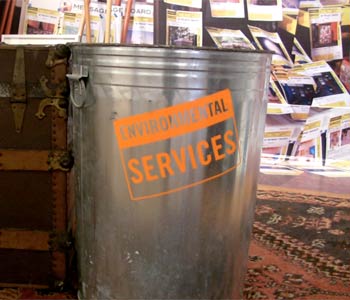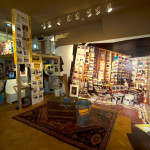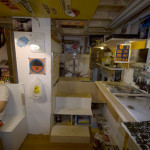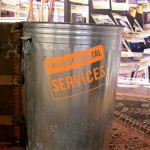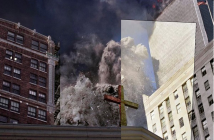ON LEMONADE & STORAGE LOFTS: A CONVERSATION WITH DOUGLAS WEATHERSBY
Douglas Weathersby creates projects that merge labor with art in complex ways, and present the results under the guise of his company, Environmental Services. Weathersby was the winner of the ICA Foster Prize in 2003, and his first commercial solo exhibition is on view at Judi Rotenberg Gallery. I sat down with Doug to talk about art, labor, and lemonade.
Matthew Nash: So, you perform labor for hire, and in the process of performing that labor you create an aesthetic or conceptual artistic experience?
Douglas Weathersby: Yes.
MN: What's the origin of that idea? How did you arrive at the decision to start Environmental Services?
DW: Coming out of grad school, I was doing lots of process and performance-based artworks. My thesis show ended up being the results from cleaning my studio, from my studio to the gallery, and cleaning the gallery. So the show was a presentation of the detritus, and of the process of obtaining the detritus.
Leaving grad school I didn't have a job. I didn't think I could or would teach, so I was thinking of what skills I had, and I had plenty of skills in stuff like cleaning, and later home repair and painting. I thought that I could combine the process-based art with the actual function of the activities I was doing.
MN: So, we're sitting in the midst of your retrospective show here at Judi Rotenberg Gallery...
DW: Yes, the ES Inaugural Retrospective and Storage Loft.
MN: "Inaugural Retrospective." Those aren't two words you usually hear back-to-back.
DW: (laughs) Yes, maybe never, I don't know. It's probably not a good idea to say them at the same time. But I feel that this is as much a show about looking forward as it is about looking back. So that's why I chose that title. It's also my first solo show.
MN: So your first solo show is also a retrospective, which a lot of artists don't usually have as their first show.
DW: Or even have the presumptuousness to put on a retrospective of their own work in the first place.
MN: So, there are two whole walls in this space which recreate your studio, and they are covered in the bills and contracts for each of the Environmental Services jobs that you've done. Is that right?
DW: Yes, since 2002.
MN: So, in the sense of this being a retrospective show, I think this is the part of the show where you are pointing to everything you did to get here, and all the labor that has been performed as both "labor" and "art."
DW: These are functional bills, and art pieces.
MN: Well I wonder, since this is all labor that you performed for pay, can you talk about the notion of now bringing this into the commercial gallery setting and trying to sell it? Are you double-dipping?
DW: Well, why not? Actually, from the beginning I've couched this project as... well, I have these certain catch-phrases I like to use. One of them is "Product Projects Art." So the idea, and I set this up with the clients, is that they can hire me to do work and I'm going to create something out of it. I'm going to make photos or documentary videos out of it, and those are for sale, and I present those as for sale to the client. It started out trying to be a completely capitalistic, money-making scheme. I've been double-dipping from the beginning.
MN: On the art side, I think of a lot of the Performance Art traditions, like Joseph Beuys and Rirkrit Tiravanija, who both explored the areas where art and labor overlap. Are those traditions you subscribe to?
DW: Beuys and Marcel Duchamp are the first two artists that I tend to think about in relation to Environmental Services. Beuys' idea of the "Social Sculptor" is, in part, what I think you're referring to. And I think Duchamp was creating contracts around his work, and the idea of the "ready made" is what inspired me to create contracts and present a job as art. It's like a "ready-made" -- work as art.
MN: But I also think of it as a boundary around the project and, at the same time, the documentation of the project. The work itself, or the labor I've seen you perform in many contexts, is very ephemeral. It exists on Monday but not on Tuesday, or in the morning but not after lunch. Containing it inside this contract is an interesting approach. Can you talk about the actual labor, maybe the shadow pieces in particular?
DW: Probably the piece I'm best known for, and the most elaborate project I did in the early days, was the "BK Boiler Room Project," where I was hired to clean up after a flood in a boiler room. I got that job right out of college, Andrew Witkin brought Barbara Krakow to my thesis show and she got to talking with Jeff Keough, and he's such a great promoter of things that he likes! I told Jeff that I was going to start this company, and he told her about it in this wonderful way of story-telling that he has. The next thing I knew, she wanted me to come over and do something at her house.
So, she had this flooded boiler room, and this problematic kitchen floor. It was this rubber subway tile kitchen floor that had the inevitable rings of dirt around each tile that she wanted me to scrub around them. It sucked, sucky job. It was a sucky sucky job.
MN: I'm leaving that in the interview!
DW: Ha! Yeah, so she also showed me the boiler room as this opportunity, and it had these great institutional red asbestos tiles that I kind of fell in love with. I started cleaning the tiles, and I started shining them up real good.
She had all of her old storage down there, so there were suitcases and lots of vintage furniture, big name vintage Modernist furniture, really great stuff just down there. So I started setting them up in the room and just sweeping the dust into the shadows of the pieces. I was photographing them and videotaping them, just making a lot of documentation of the project.
I ended up spending about, I don't know how long... but over a year period I'd go there every month or so. She was very gracious in letting it be this open-ended thing. I ended up deciding that the room itself was just incredible, and the boiler and the floor were the thing about the room, they were the sculpture. So I decided to paint everything that wasn't the boiler and the floor gallery white, as a way to kind of put them on a pedestal.
MN: I keep thinking about the project you did in downtown Boston, one of the art windows projects. It seems that that piece is more about promotion than labor. What about the branding and advertising you do? How do you think about that aspect of Environmental Services?
DW: Well, that project was part of Boston Art Windows, where artists were given space in that area. Mine was across from the new Ritz Carlton, it was between renters and it seemed like it had not been used for a while. Except, oddly enough, for other Art Windows projects, so there were ladders and other people's old pedestals and weird support structures. I couldn't figure out what these old structures were for. I was trying to think of what I was going to do, in terms of having this storefront, so I decided to make it one half advertisement and one half mock work site. So it was a fake work site and advertising scheme.
I used the quintessential construction material, at least for me, which was this rosin paper and blue tape. You always see those covering windows. Construction workers always cover over windows so no one can see what laws they're breaking, or whatever they're doing in there.
So I continued to "protect the room," because that's also what it's used for, to protect floors and other surfaces during construction projects. So I then wrapped the rest of the room, like Christo, and all of the objects in the room, with this pink paper and blue tape. These weird objects that had been left behind became part of this sculptural installation. I also had in the windows, my advertising piece, I made logos out of the pink paper and blue tape as a way of getting those peepholes into the work site.
MN: When I think about your branding, I know that you have created a very distinctive Environmental Services identity. You have to logos and your van, and you wear ES outfits to promote yourself. But then you have these other marketing strategies that border on the idiotic, or the juvenile. You sell lemonade, for example...
DW: I took the idea of the kids' lemonade stand and used that as a way of advertising. You know, when I'm approached by an advertiser I don't tend to want to take anything they've got, so I wanted to actually have something that someone might want to take away. I thought that having a lemonade stand would be great because who doesn't like lemonade? I can't imagine not wanting lemonade. I love lemonade.
So, I spend a lot of time at home trying to figure out how to make lemonade really good. I like the lemonade I make, it's really strong and sour and sweet, it's really good. Anyway, so I videotaped the process of making the lemonade, because I thought it would be really interesting to make it and document the process as a way of illustrating how I do an Environmental Services task. It's like a video of me sweeping the floor -- you don't see me sweeping the floor but you see this video of something beautiful that comes out of that task. So I wanted to recreate that microcosm in the making of the lemonade.
So I serve this lemonade to anyone who wants some, and they see this video of me making the lemonade. Of course, the cups have my logo and website on them, in case they are interested in checking it out.
MN: What are some expectations people should have about your retrospective show?
DW: Well, the retrospective is about bringing art to functionality, or functionality to art, which is what Environmental Services is about. I brought that idea to this show. I just bought a house, and I'm having to move out of my studio to pay for the house, so I've brought, as a retrospective, everything I'm storing in my studio to store in the gallery for the month. I've created an installation out of the by-products of Environmental Services from the last seven years and all that other stuff leading up to ES' conception.
- Click image to take a short video tour of the ES Inaugural Restrospective and Storage Loft (Quicktime required, 4MB)
Judi Rotenberg Gallery
Environmental Services
"Douglas Weathersby: ES Inaugural Restrospective and Storage Loft" is on view January 8 - February 1, 2009 at Judi Rotenberg Gallery.
All images are courtesy of the artist and Judi Rotenberg Gallery. Images and video by the author.

